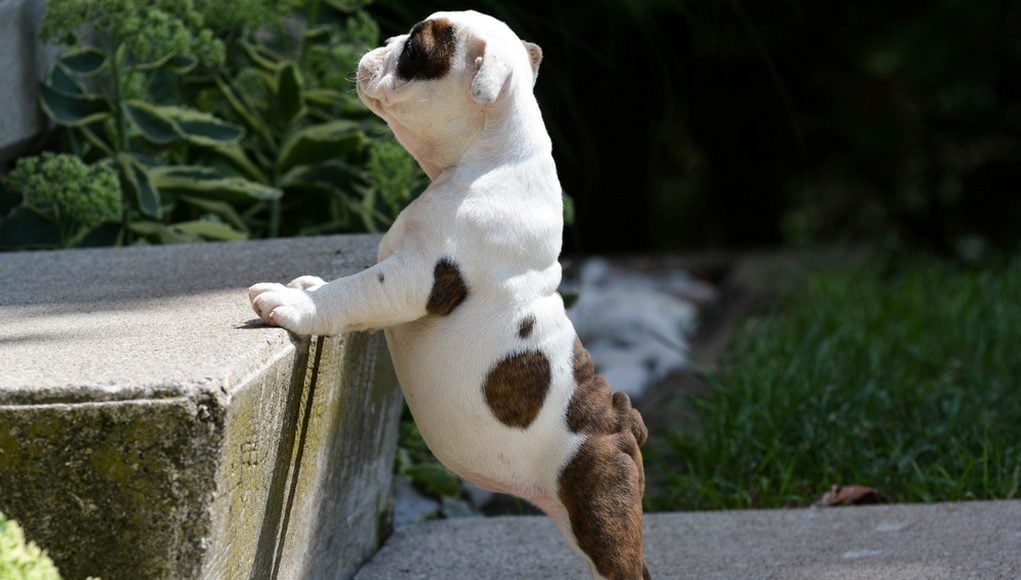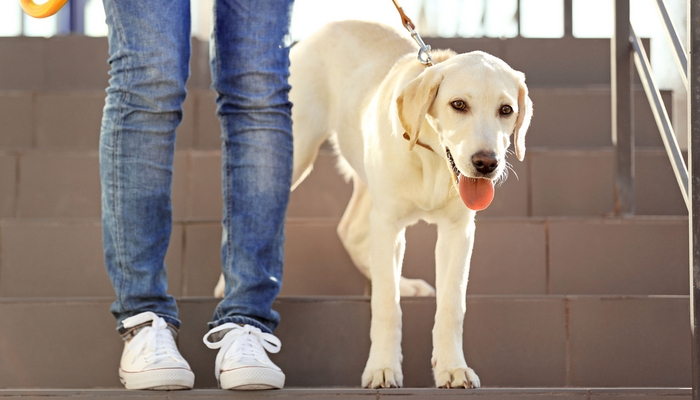Dogs need stairs or steps for a number of reasons. Some dogs need pet stairs to help their injured backs or limbs, or to avoid injury altogether. Senior dogs need to learn to use pet ramps to get up and down from the places their aging bodies are no longer able to comfortably handle.
Let's not forget that dogs that have no experience with going up or down the steps, and will often try to learn how to navigate them. Whatever the reason, there will likely come a time when you're going to need to show a dog how to climb stairs. Depending on your canine – this could be a simple task or it could take a lot of time and patience.
 More talented dog breeds may happily jump up stairs with ease. However, not every dog is curious about steps. Some dogs are frightened of climbing over obstacles. It may take a lot of coaxing (and even more doggy treats) to get a dog over this hurdle and onto stairs.
More talented dog breeds may happily jump up stairs with ease. However, not every dog is curious about steps. Some dogs are frightened of climbing over obstacles. It may take a lot of coaxing (and even more doggy treats) to get a dog over this hurdle and onto stairs.
Then there are senior dogs and pets with health issues that prevents them from climbing stairs comfortably. If your dog is in this situation, you need to talk to your vet before trying any of these tips and tricks. If your dog shouldn't be climbing steps, you're going to need to find a way around it (and that's usually using special dog ramps).
READ ALSO: How To Help A Dog Get Onto A Bed or Car and Manage Heights
How to Train a Dog to Use Pet Steps and Stairs
Teaching SMALL DOGS or PUPPIES to use steps/stairs
More often than not, it's small dogs and puppies that are having trouble with stairs.
Using specially designed dog steps are a great way to make sure your dog gets safely up and down from the couch, bed, car and other elevated spaces without injuring himself or aggravating an existing condition.
Many of the dogs who have to use doggy steps are small dogs with back, muscle, or joint problems. When they jump down, it is particularly hazardous to their body and puts a large amount of strain and pressure on it.
We assume that most dogs understand how to climb steps, but in reality, many dogs need to be trained to use steps and stairs. It isn’t a natural movement for them, so it will take some convincing until they feel that using regular stairs or special pet steps and ramps is a normal mobility option.
 Start by using training dog treats:
Start by using training dog treats:
The easiest way to accomplish this training is by using dog treats. You can simply place a treat on the first step, and add to each step until your dog has it down.
Then, start placing a dog treat only on the top step and on the couch (or bed, or car).
Make sure never to give treats when the dog refrains from using the steps. Positive reinforcement must be reinforced. Before long, your dog should be making the positive association with using the regular stairs or pet steps as opposed to jumping.
You can do this the reverse way to teach your dog to come down the steps. It'll be tougher for the dog to learn to go down the stairs than going up the stairs. Why? Because descending steps is an awkward movement for animals with 4 legs; it just is.
It’s a good idea to gently assist your dog the first few times up and down the stairs.
This will give him security and reassurance that it is a safe environment, and you are encouraging the motion. If you have a second dog, then him demonstrating how to climb up the stairs can be of huge help to your other pet. Observational learning is one of the very effecting dog training tricks based in psychology that works well.
It is also a good idea to place a non-slip mat or rug at the bottom of the stairs or even pet steps so that slipping doesn’t occur. This will give everyone confidence, too.
RELATED: Dog Ramps vs Dog Stairs – How to Decide?
 How to teach SENIOR DOGS to use stairs or pet steps
How to teach SENIOR DOGS to use stairs or pet steps
When your dog is getting older, it is wise to gradually start teaching him to use pet steps and dog ramps in order to (when the time comes) get onto elevated furniture, in and out of cars, and anywhere else which would usually require some jumping on the dog’s part.
Be sure to choose steps and ramps with an anti-skid surface, to ensure the dog’s safety and comfort. Some dog steps, stairs and ramps are specifically good for canine arthritis.
Again, try using dog treats first:
Same as with teaching small dogs and puppies to use stairs, using dog treats to bribe your dog to start using a ramp, ideally, (or dog steps, stairs) is a good idea to start with.
Ramps are great for senior dogs. It is best to begin with the ramp on a flat surface with no incline, so your dog can first get used to the feel of walking on the sloped surface.
Using dog treats, get the dog to walk on the ramp. If he refuses, you can start by rewarding for one paw on the ramp. Then only reward for two paws on the ramp. Then only reward once the dog reaches the ramp’s middle.
Keep progressing and withholding the treats for longer throughout the process until finally the dog will cross the entire ramp and go back again before receiving a treat.
Next, complete these steps using only basic commands and forgetting about the treats. The goal is to get the dog to listen to you at any point you decide to instruct him to use a ramp.
After you are both comfortable with things, put the ramp at a slight incline, and repeat the steps above. Once the dog can comfortably get up the ramp, repeat all steps in order to get the dog to go down the ramp.
With enough repetition and positive reinforcement, your dog should soon be comfortable using dog ramps and stairs to get up and down.
RECOMMENDED: How To Choose the Best Dog Stairs or Dog Ramp
How to train dogs who FEAR stairs
Some dogs are terrified to go up or down steps. This could be due to a past trauma, or simply due to the fact that ascending and descending stairs is not a natural movement for many animals to make.
It could also be due to the fact that some dogs don’t experience homes with stairs until much later in life than others. If your dog fears the stairs, training methods should be gentle, quick, and positive.
DO NOT force the dog up or down steps.
There should never be any negative association with steps on the dog's part.
The best training methods for training a fearful dog to use the stairs is positive reinforcement, praise, and good dog treats. Before you begin training your dog to not fear the steps, do make sure that there isn’t something medical or physical going on which is causing him pain while using the stairs.
If your dog has been cleared medically, use the method described in the first section for the same results. This might take longer, since there are usually more steps involved, paired with a fear of steps in general.
Offer the dog a treat every time he gets to a new step or makes any progress whatsoever. Remember to go heavy on the praise when the dog goes up or down the stairs properly.
Besides dog treats, play goes a long way in training and reinforcement. Make sure to play some games with your dog while trying to teach him to not fear the stairs.
RELATED: How Dog Stairs Can Help A Dog with Arthritis
Aim to train a dog for the LONG TERM
Make sure to remain encouraging and supportive by either going side-by-side with your dog up and down the stairs, or by staying behind him to provide an extra sense of security and safety.
Remember to talk the whole time so your dog always knows where you are.
If treats and positive reinforcement aren’t working for you, you can think outside of the box by throwing a blanket over the ramp or the stairs and luring the dog up. The blanket can take away the confusing geometric aspect of the stairs and instead make them seem more like a singular hill. Dogs and humans alike find hills much easier to climb than staircases.
With all of these methods, remember to be consistent, be patient, and reward every tiny little bit of progress to ensure the success of your dog in learning how to use doggy steps, ramps, or human stairs.
READ NEXT: 15 Tips on Pet Proofing Your Home in Preparation for a New Dog
















